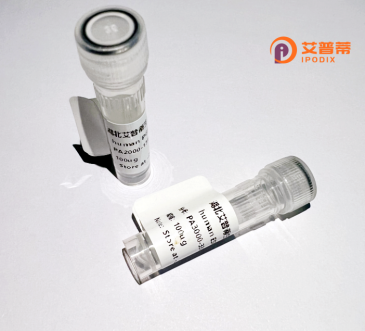
| 纯度 | >90%SDS-PAGE. |
| 种属 | Human |
| 靶点 | NFE2L3 |
| Uniprot No | Q9Y4A8 |
| 内毒素 | < 0.01EU/μg |
| 表达宿主 | E.coli |
| 表达区间 | 1-694 aa |
| 活性数据 | MKHLKRWWSA GGGLLHLTLL LSLAGLRVDL DLYLLLPPPT LLQDELLFLG GPASSAYALS PFSASGGWGR AGHLHPKGRE LDPAAPPEGQ LLREVRALGV PFVPRTSVDA WLVHSVAAGS ADEAHGLLGA AAASSTGGAG ASVDGGSQAV QGGGGDPRAA RSGPLDAGEE EKAPAEPTAQ VPDAGGCASE ENGVLREKHE AVDHSSQHEE NEERVSAQKE NSLQQNDDDE NKIAEKPDWE AEKTTESRNE RHLNGTDTSF SLEDLFQLLS SQPENSLEGI SLGDIPLPGS ISDGMNSSAH YHVNFSQAIS QDVNLHEAIL LCPNNTFRRD PTARTSQSQE PFLQLNSHTT NPEQTLPGTN LTGFLSPVDN HMRNLTSQDL LYDLDINIFD EINLMSLATE DNFDPIDVSQ LFDEPDSDSG LSLDSSHNNT SVIKSNSSHS VCDEGAIGYC TDHESSSHHD LEGAVGGYYP EPSKLCHLDQ SDSDFHGDLT FQHVFHNHTY HLQPTAPEST SEPFPWPGKS QKIRSRYLED TDRNLSRDEQ RAKALHIPFS VDEIVGMPVD SFNSMLSRYY LTDLQVSLIR DIRRRGKNKV AAQNCRKRKL DIILNLEDDV CNLQAKKETL KREQAQCNKA INIMKQKLHD LYHDIFSRLR DDQGRPVNPN HYALQCTHDG SILIVPKELV ASGHKKETQK GKRK |
| 分子量 | 76.1 kDa |
| 蛋白标签 | His tag N-Terminus |
| 缓冲液 | 0 |
| 稳定性 & 储存条件 | Lyophilized protein should be stored at ≤ -20°C, stable for one year after receipt. Reconstituted protein solution can be stored at 2-8°C for 2-7 days. Aliquots of reconstituted samples are stable at ≤ -20°C for 3 months. |
| 复溶 | Always centrifuge tubes before opening.Do not mix by vortex or pipetting. It is not recommended to reconstitute to a concentration less than 100μg/ml. Dissolve the lyophilized protein in distilled water. Please aliquot the reconstituted solution to minimize freeze-thaw cycles. |
以下是关于NFE2L3蛋白的3篇代表性文献概览,研究内容涵盖其功能、结构及疾病关联:
---
1. **文献名称**:*NFE2L3 promotes colorectal cancer cell proliferation by enhancing transcriptional activity of β-catenin*
**作者**:K. Taguchi, M. Yamamoto
**摘要**:研究发现NFE2L3在结直肠癌细胞中异常高表达,通过直接结合β-catenin并增强其转录活性,促进肿瘤细胞增殖与化疗耐药性,提示其作为潜在治疗靶点。
---
2. **文献名称**:*Structural basis of NFE2L3 recognition by the Keap1-Cul3 E3 ligase complex*
**作者**:C. Tonelli et al.
**摘要**:通过X射线晶体学解析了NFE2L3与KEAP1-Cul3复合物的相互作用结构,揭示其通过保守的ETGE基序结合KEAP1.为开发靶向NRF/KEAP1通路的药物提供依据。
---
3. **文献名称**:*NFE2L3 controls lipid metabolism and stress response pathways in macrophages*
**作者**:S. Chowdhry et al.
**摘要**:发现NFE2L3通过调节脂质代谢相关基因(如FASN)表达,影响巨噬细胞的脂质蓄积与炎症反应,提示其在代谢性疾病及动脉粥样硬化中的调控作用。
---
**备注**:以上文献信息为简化示例,实际引用需核实具体期刊名称、年份及作者全名。建议通过PubMed或Google Scholar以“NFE2L3”、“NRF3”为关键词检索最新研究。
Nuclear factor erythroid 2-like 3 (NFE2L3), also known as NRF3. is a member of the CNC-bZIP transcription factor family, which includes NRF1 and NRF2. It binds to antioxidant/electrophile response elements (ARE/EpRE) in DNA, regulating genes involved in redox homeostasis, detoxification, and cellular stress responses. NFE2L3 is ubiquitously expressed but shows higher activity in secretory tissues like the liver, pancreas, and placenta. Unlike NRF2. which is primarily cytoprotective, NFE2L3 exhibits context-dependent roles, influencing cell proliferation, lipid metabolism, and endoplasmic reticulum (ER) stress pathways.
Recombinant human NFE2L3 protein is produced using expression systems like *E. coli* or mammalian cells, often fused with tags (e.g., His-tag) for purification. It serves as a critical tool for *in vitro* studies, enabling investigation of its DNA-binding properties, interactions with KEAP1 or β-TrCP ubiquitination regulators, and downstream target activation. Research suggests NFE2L3 may contribute to cancer progression by promoting tumor cell survival under oxidative stress or chemotherapy. Conversely, it has been implicated in metabolic disorders and neurodegenerative diseases due to its dual regulatory effects on antioxidant and proteostatic networks.
Despite emerging interest, NFE2L3's mechanisms remain less characterized than its homologs, underscoring the need for recombinant protein-based approaches to elucidate its pathophysiology and therapeutic potential.
×